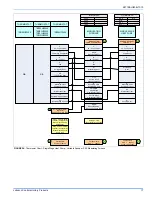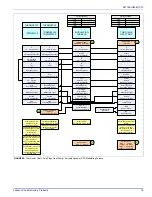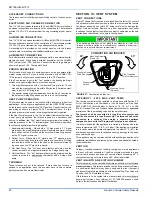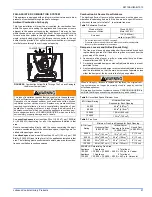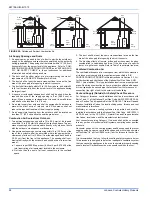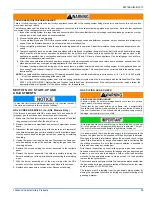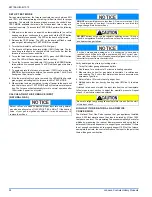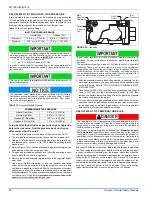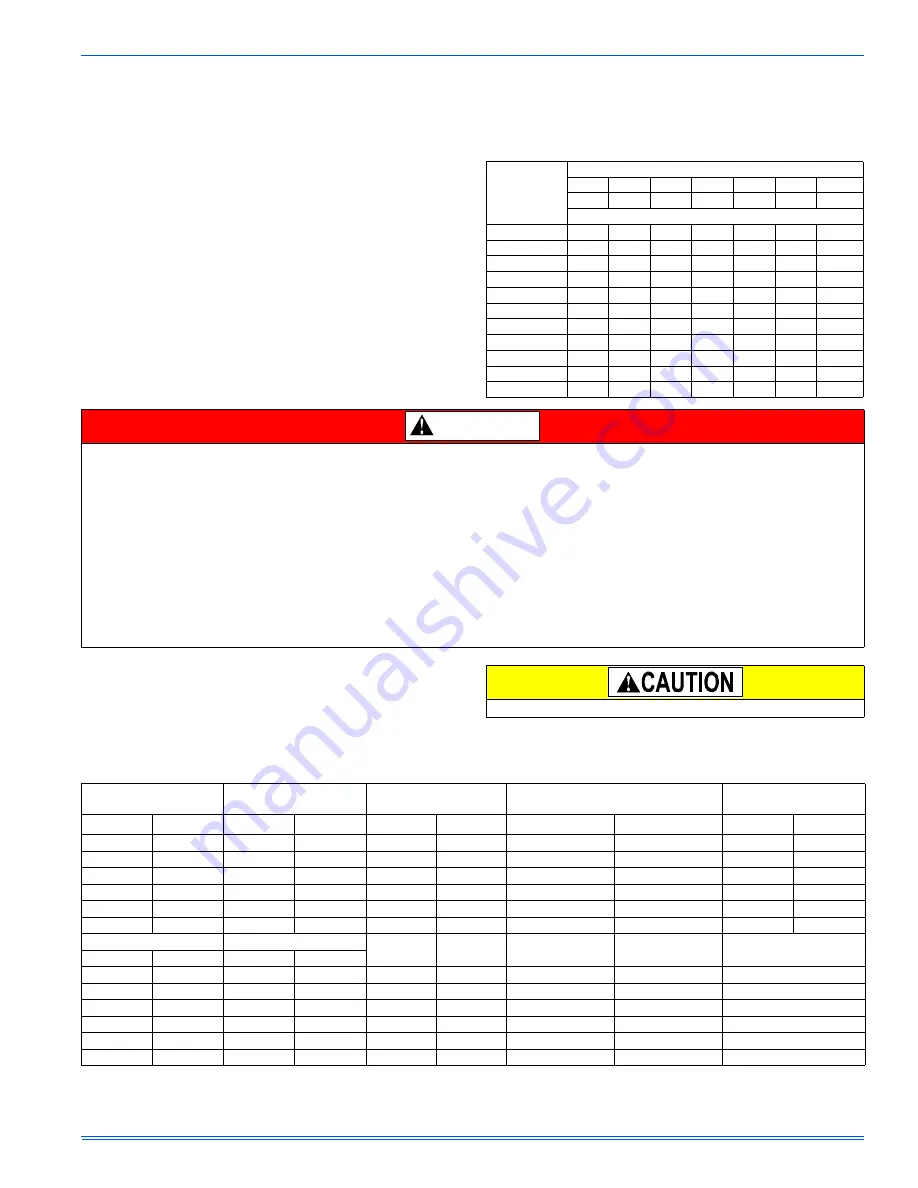
987158-UIM-B-1013
Johnson Controls Unitary Products
11
The factory gas orifice sizes are based on a gas heating value of
1030 BTU/Cu.ft., so if your gas value is significantly higher or
lower than that, it may be necessary to change to smaller or larger
gas orifices.
The chart below shows recommended gas orifice sizes to use at vari-
ous altitudes and at various de-ration levels. To use the chart, follow
these instructions:
1. Clock the gas meter and calculate the actual input rate using your
local gas heating value. See "CALCULATING THE FURNACE
INPUT (NATURAL GAS)" in this manual.
2. Divide that input rate by the input rate shown on the furnace rating
plate to get the actual de-ration percent.
3. Read down the left-hand “Actual Rate” column to find the closest
number to your actual de-ration percent.
4. Read across that row to the column for the elevation at your location.
The number listed there is the orifice size that is proper for your unit.
Example – You have a 100,000 BTU/H furnace installed at an elevation
of 6,000 feet. You clock the gas meter and find that the furnace is actu-
ally fired at 64,000 BTU/H. Divide 64,000 by 100,000, which gives 0.64
(64%). The closest number to 64% in the left-hand “Actual Rate” col-
umn is 65. Read across that row to the column for 6,000 feet elevation,
which shows “#43”. You should change from the factory #45 orifices to
larger #43 orifices, which will bring the input rate back up to approxi-
mately 76,000 BTU/H, which is what it should be for that furnace at
6,000 feet.
SECTION V: ELECTRICAL POWER
ELECTRICAL POWER CONNECTIONS
Field wiring to the unit must be grounded. Electric wires that are field
installed shall conform to the temperature limitation for 63°F (35°C) rise
wire when installed in accordance with instructions. Refer to Table 6 in
these instructions for specific furnace electrical data.
* If chimney kit S1-1CK0605 is installed, minimum inputs and outputs are 65% of maximum, not 50%. See Chimney kit instructions and label for more details.
Annual Fuel Utilization Efficiency (AFUE) numbers are determined in accordance with DOE Test procedures.
Wire size and over current protection must comply with the National Electrical Code (NFPA-70-latest edition) and all local codes.
The furnace shall be installed so that the electrical components are protected from water.
Table 5:
High Altitude Orifices
Actual Rate
(percent of
nameplate)
Elevation in Feet Above Sea Level
4,000 5,000 6,000 7,000 8,000 9,000 10,000
84%
80%
76%
72%
68%
64% 60%
Orifice Drill Size
100
48 49 49 50 51 51 52
95
47 48 49 50 50 50 51
90
46 47 48 49 49 49 50
85
45 46 47 48 49 49 50
80
45 45 46 47 48 48 49
75
44 45 45 45 47 47 49
70
43 44 44 45 45 45 48
65
42 43 43 44 45 45 47
60
41 42 42 43 44 45 46
55
40 41 41 32 43 43 44
50
39 40 40 40 43 42 42
PROPANE KITS
It is very important to choose the correct kit and/or gas orifices for the altitude and the type of gas for which the furnace is being installed.
Only use natural gas in furnaces designed for natural gas. Only use propane (LP) gas for furnaces that have been properly converted to use pro-
pane (LP) gas. Do not use this furnace with butane gas.
Incorrect gas orifices or a furnace that has been improperly converted will create an extremely dangerous condition resulting in premature heat
exchanger failure, excessive sooting, high levels of carbon monoxide, personal injury, property damage, a fire hazard and/or death.
Propane (LP) conversions are required in order for the appliance to satisfactory meet the application.
An authorized distributor or dealer must make all gas conversions.
In Canada, a certified conversion station or other qualified agency, using factory specified and/or approved parts, must perform the conversion.
The installer must take every precaution to insure that the furnace has been converted to the proper gas orifice size when the furnace is installed.
Do not attempt to drill out any orifices to obtain the proper orifice size. Drilling out a gas orifice will cause misalignment of the burner flames, caus-
ing premature heat exchanger burnout, high levels of carbon monoxide, excessive sooting, a fire hazard, personal injury, property damage and/or
death.
DANGER
Use copper conductors only.
Table 6:
Ratings & Physical / Electrical Data
Input
Max/Min *
Output
Max/Min *
Nominal
Airflow
Air Temp. Rise
Max Input
Air Temp. Rise
Min Input
MBH
kW
MBH
kW
CFM
m
3
/min
°F
°C
°F
°C
60/30
17.6/8.8
47/24
13.8/7.0
1200
34.0
30-60
17-33
20-50
11-28
80/40
23.5/11.8
62/32
18.2/9.4
1200
34.0
40-70
22-39
20-50
11-28
80/40
23.5/11.8
62/32
18.2/9.4
1600
45.3
35-65
19-36
20-50
11-28
100/50
29.3/14.7
78/40
22.8/11.7
1600
45.3
35-65
19-36
20-50
11-28
100/50
29.3/14.7
78/40
22.8/11.7
2000
56.6
35-65
19-36
20-50
11-28
120/60
33.7/16.9
95/48
27.8/14.1
2000
56.6
45-75
25-42
25-55
13-31
Max. Outlet Air Temp
Blower
Blower
Wheel size
AFUE
%
Max Over-Current
Protect
Total Unit
Amps
Min. wire Size (awg)
@ 75 ft one way
°F
°C
HP
Amps
160
71.1
1/2
4.8
11 x 8
80.0
15
7.0
14
170
76.7
1/2
4.8
11 x 8
80.0
15
7.5
14
165
73.9
3/4
7.5
11 x 10
80.0
15
10.0
14
165
73.9
3/4
7.5
11 x 10
80.0
15
10.0
14
165
73.9
1
14.5
11 x 11
80.0
20
12.0
12
175
79.4
1
14.5
11 x 11
80.0
20
12.0
12

















